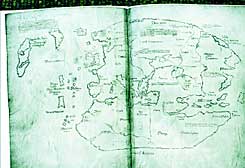50 years before Columbus

the map. Europe, Asia, Africa, and across the Atlantic Ocean - a place called Vinland
Direct link to this page: https://www.hayadan.org.il/vinland1.html
The latest scientific analysis of the "Vineland Map" states that the map was drawn 50 years before Christopher Columbus set out on the journey that eventually led him to America. The conclusion contradicts the conclusion of a previous study which stated that the map is fake.
The Vineland map was revealed to the world in 1965 by researchers at Yale University, where it is today. The map depicts Europe, Asia, Africa - and, across the Atlantic, a place called Vinland.
According to the hypothesis, this is the place where the Viking Leif Eriksson arrived around 1000 AD, and it is so named because of the many vines that grew there. If the map is authentic, its value is estimated at about 20 million dollars.
The new study was conducted by Jacqueline Olin of the Smithsonian Center for Materials Research in Maryland. In August 2002, in an article published in the journal "Radiocarbon", Olin determined that the skin from which the parchment on which the map was drawn was made was removed from an animal in 1434, more than half a century before Columbus "discovered" America. There were even some scholars who speculated that Columbus used the map to find the New World in 1492.
However, in the same month, a study was published in the journal "Chemistry Analytical" which stated that the ink used to draw the map contains anatase, a type of titanium dioxide not known to have been produced before 1920. Anatase is also found in nature, but according to the researchers who deny the authenticity of the Vinland map, the form in which It appears on the map cannot be natural.
Now, in a study published in the December issue of Analytical Chemistry, Olin claims that antase may be a byproduct of the ink production process in the Middle Ages, just like other minerals found in ink, including aluminum, copper and zinc. The shape of the crystals, she adds, could have changed over time. Alongside the chemical research, scientists are now continuing to investigate the Latin text that appears on the map.
https://www.hayadan.org.il/BuildaGate4/general2/data_card.php?Cat=~~~699443068~~~162&SiteName=hayadan
